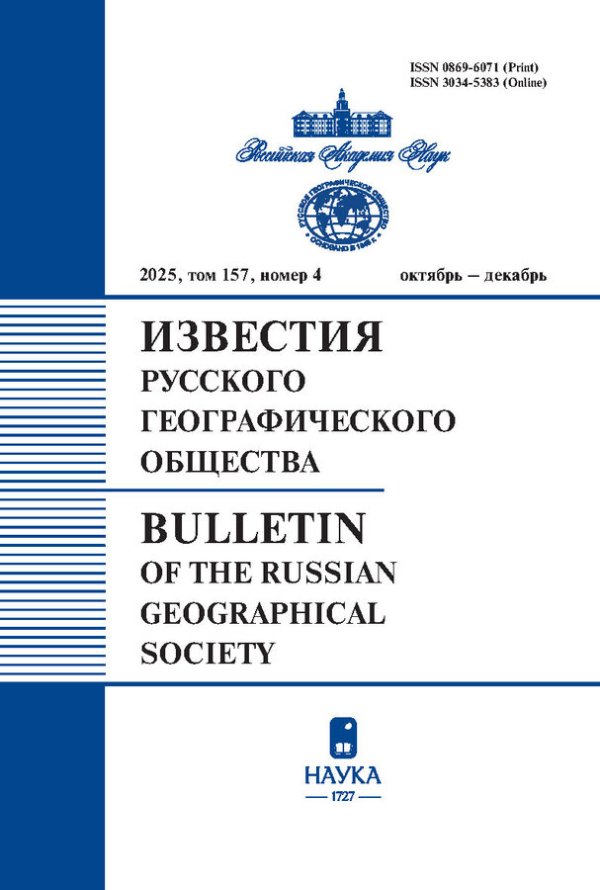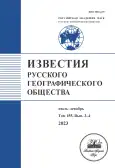Морфодинамика русла р. Коса как отражение направленности русловых процессов в долинах развития озерно-ледниковых террас (бассейн Верхней Камы)
- Авторы: Назаров Н.Н.1, Петрова В.И.2, Фролова И.В.2
-
Учреждения:
- Тихоокеанский институт географии Дальневосточного отделения Российской академии наук
- Пермский государственный национальный исследовательский университет
- Выпуск: Том 155, № 3-4 (2023)
- Страницы: 100-112
- Раздел: Статьи
- URL: https://journals.rcsi.science/0869-6071/article/view/254229
- DOI: https://doi.org/10.31857/S0869607123030102
- EDN: https://elibrary.ru/NWDGJF
- ID: 254229
Цитировать
Полный текст
Аннотация
Статья посвящена выявлению особенностей развития русловых процессов в речных долинах с распространением озерно-ледниковых террас. В качестве примера выбрана р. Коса – крупнейший правобережный приток верхнего течения Камы. Для дешифрирования космических снимков и получения количественной информации использовались ресурсы GoogleEarthPro и Яндекс Карты. На основе анализа элементов пойменно-русловых комплексов проведена морфодинамическая типизация русла. В качестве особенностей развития русловых процессов на участках распространения озерно-ледниковой террасы рассматривался показатель соотношения ширины поймы к ширине долины. В верхнем течении Косы (за пределами Косинской низменности) это соотношение составляет 1 : 1, в среднем – 1 : 9, в нижнем – 1 : 3. К особенностям развития русловых процессов относится расположение пояса меандрирования строго в левой прибортовой части долины, что указывает на наличие в прошлом устойчивого и продолжительного по времени смещения русла с востока на запад. Для верхнего течения реки ведущими морфодинамическими типами русла являются свободные сегментные излучины и адаптированное прямолинейное русло. В среднем течении Косы, в котором большая часть долины представлена озерно-ледниковой террасой, при сохранении ведущей роли сегментных излучин значимую роль в структуре морфодинамических типов русел уже играют вынужденные излучины. При этом наблюдается высокая доля распространения адаптированного прямолинейного русла.
Об авторах
Н. Н. Назаров
Тихоокеанский институт географии Дальневосточного отделения Российской академии наук
Автор, ответственный за переписку.
Email: nikolainazarovpsu@gmail.com
Россия, Владивосток
В. И. Петрова
Пермский государственный национальный исследовательский университет
Автор, ответственный за переписку.
Email: verapetrova182000@gmail.com
Россия, Пермь
И. В. Фролова
Пермский государственный национальный исследовательский университет
Автор, ответственный за переписку.
Email: irvik13@gmail.com
Россия, Пермь
Список литературы
- Большиянов Д.Ю., Веркулич С.Р. Каналы стока талых ледниковых вод и возможности палеогеографических реконструкций // Изв. РГО. 1990. Т. 122. Вып. 1. С. 58–64.
- Дедков А.П. Экзогенное рельефообразование в Казанско-Ульяновском Поволжье. Казань: Изд-во Казан. ун-та, 1970. 255 с.
- Демаков Д.А., Лычагина Е.Л., Зарецкая Н.Е. и др. Косинские мезолитические стоянки в контексте истории природной среды Верхнего Прикамья в позднеледниковье и раннем голоцене // Геоморфология. 2023. № 1. С. 91–106.
- Зайцев В.К. К истории современных долин рек Вишерки и Березовки (правых притоков Колвы) // Известия Всесоюзн. геогр. общ-ва. 1941. Т. 73. Вып. 2. С. 287–291.
- Земцов А.А., Бураков Д.А. Современные геоморфологические процессы в центральной части Западно-Сибирской равнины // Проблемы геоморфологии и неотектоники платформенных областей Сибири. Новосибирск: Наука, 1970. С. 87–99.
- Коротаев В.Н., Михайлов В.Н., Бабич Д.Б. и др. Гидролого-морфологические процессы, динамика гидрографической сети и русловые деформации в дельте р. Лены // Земельные и водные ресурсы: противоэрозионная защита и регулирование русел. М.: Изд-во Моск. ун-та, 1990. С. 120–144.
- Лавров А.С., Потапенко Л.М. Неоплейстоцен Печерской низменности и Западного Притиманья (стратиграфия, палеогеография, хронология). М.: ОАО “Можайский полиграфический комбинат”, 2012. 191 с.
- Лавров А.С., Потапенко Л.М. Неоплейстоцен северо-востока Русской равнины. М.: Аэрогеология, 2005. 348 с.
- Махинов А.Н. Эоловые формы рельефа в пойме реки Амур // Геоморфология. 2017. № 2. С. 52–62.
- Назаров Н.Н., Егоркина С.С. Реки Пермского Прикамья: Горизонтальные русловые деформации. Пермь: Изд-во “Звезда”, 2004. 155 с.
- Рябков Н.В. Перестройка речных систем северо-востока Русской равнины в связи с древними оледенениями этого района // Проблемы перестройки и перехвата речных долин. М., 1975. С. 59–70.
- Чалов Р.С. Влияние эоловых процессов (фактора ветра) на формирование и морфологию русел и пойм равнинных рек // Географический вестник. 2022. № 2 (61). С. 6–16. https://doi.org/10.17072/2079-7877-2022-2-6-16
- Чалов Р.С. Русловедение: теория, география, практика. Т. 2: Морфодинамика речных русел. М.: КРАСАНД, 2011. 960 с.
- Чалов Р.С., Чалов С.Р. Структурные уровни и морфодинамическая классификация русловых разветвлений // Водные ресурсы. 2020. Т. 47. № 3. С. 259–271.
- Чалов Р.С., Чалов С.Р. Структурные уровни русловых процессов и морфодинамические типы русла // Тридцать седьмое пленар. межвуз. координац. совещание по проблемам эрозионных, русловых и устьевых процессов. М., 2022. С. 170–173.
- Чалов Р.С., Штанкова Н.Н. Сток наносов, руслоформирующие расходы воды и морфодинамические типы русел рек бассейна Камы // Вопросы физической географии и геоэкологии Урала. Пермь, 2000. С. 99–116.
- Heggen M.P., Birks H.H., Heiri O., Grytnes J.A., Birks H.J.B. Are fossil assemblages in a single sediment core from a small lake representative of total deposition of mite, chironomid, and plant macrofossil remains? // Journal of Paleolimnology. 2012. 48: 669–691.
Дополнительные файлы















